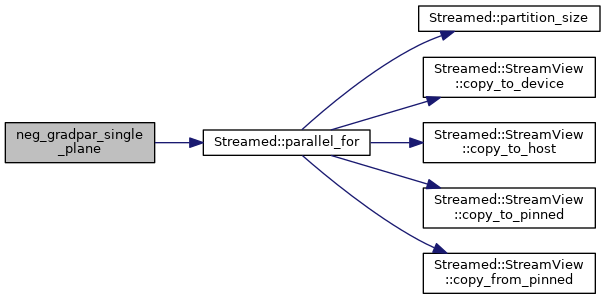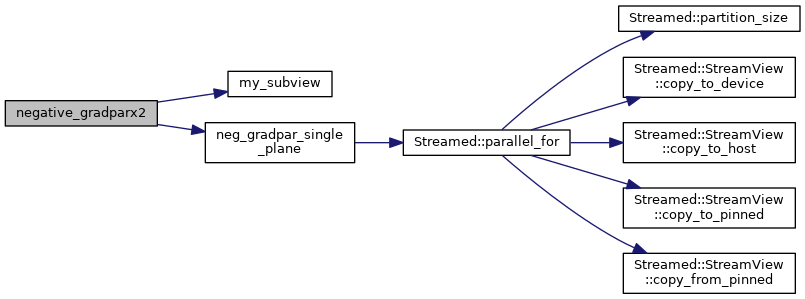
Functions | |
| void | neg_gradpar_single_plane (const View< int *, CLayout, DeviceType > &is_inside, const Projection< DeviceType > &projection, const Kokkos::View< double *, Kokkos::LayoutRight, DeviceType > &input_left, const Kokkos::View< double *, Kokkos::LayoutRight, DeviceType > &input_center, const Kokkos::View< double *, Kokkos::LayoutRight, DeviceType > &input_right, const Kokkos::View< double *, Kokkos::LayoutRight, DeviceType > &output, double sgn, Order derivative_order) |
| void | negative_gradparx2 (const GradParXTmp &gpxt, const Kokkos::View< double **, Kokkos::LayoutRight, DeviceType > &input, const Kokkos::View< double **, Kokkos::LayoutRight, DeviceType > &output, Order derivative_order) |
Function Documentation
◆ neg_gradpar_single_plane()
| void neg_gradpar_single_plane | ( | const View< int *, CLayout, DeviceType > & | is_inside, |
| const Projection< DeviceType > & | projection, | ||
| const Kokkos::View< double *, Kokkos::LayoutRight, DeviceType > & | input_left, | ||
| const Kokkos::View< double *, Kokkos::LayoutRight, DeviceType > & | input_center, | ||
| const Kokkos::View< double *, Kokkos::LayoutRight, DeviceType > & | input_right, | ||
| const Kokkos::View< double *, Kokkos::LayoutRight, DeviceType > & | output, | ||
| double | sgn, | ||
| Order | derivative_order | ||
| ) |
Calculates the gradient of the input array. Includes a precomputation to check which nodes are inside the boundary provided. This could be done once in grid setup and stored. This code is called from Fortran and is self-contained. Thus, everything needed is passed from Fortran to C++ even though grid information is already in the C++ grid object. It will eventually be refactored accordingly.
- Parameters
-
[in] nseg is the number of boundary segments(?) [in] sml_bt_sign is the user-input direction of the toroidal magnetic field [in] tr_fort is an array of the triangles the corresponding to the field-following path through the vertex [in] p_fort is an array of the weights of the three triangle vertices for tr_fort triangles [in] dx_fort is an array of distances [in] bd_fort is an array of the boundary segments [in] input is the potential [out] output is the gradient of the potential [in] derivative_order is which derivative to take
- Returns
- void


◆ negative_gradparx2()
| void negative_gradparx2 | ( | const GradParXTmp & | gpxt, |
| const Kokkos::View< double **, Kokkos::LayoutRight, DeviceType > & | input, | ||
| const Kokkos::View< double **, Kokkos::LayoutRight, DeviceType > & | output, | ||
| Order | derivative_order | ||
| ) |
Calculates the gradient of the input array. Includes a precomputation to check which nodes are inside the boundary provided. This could be done once in grid setup and stored. This code is called from Fortran and is self-contained. Thus, everything needed is passed from Fortran to C++ even though grid information is already in the C++ grid object. It will eventually be refactored accordingly.
- Parameters
-
[in] nseg is the number of boundary segments(?) [in] sml_bt_sign is the user-input direction of the toroidal magnetic field [in] tr_fort is an array of the triangles the corresponding to the field-following path through the vertex [in] p_fort is an array of the weights of the three triangle vertices for tr_fort triangles [in] dx_fort is an array of distances [in] bd_fort is an array of the boundary segments [in] input is the potential [out] output is the gradient of the potential [in] derivative_order is which derivative to take
- Returns
- void

